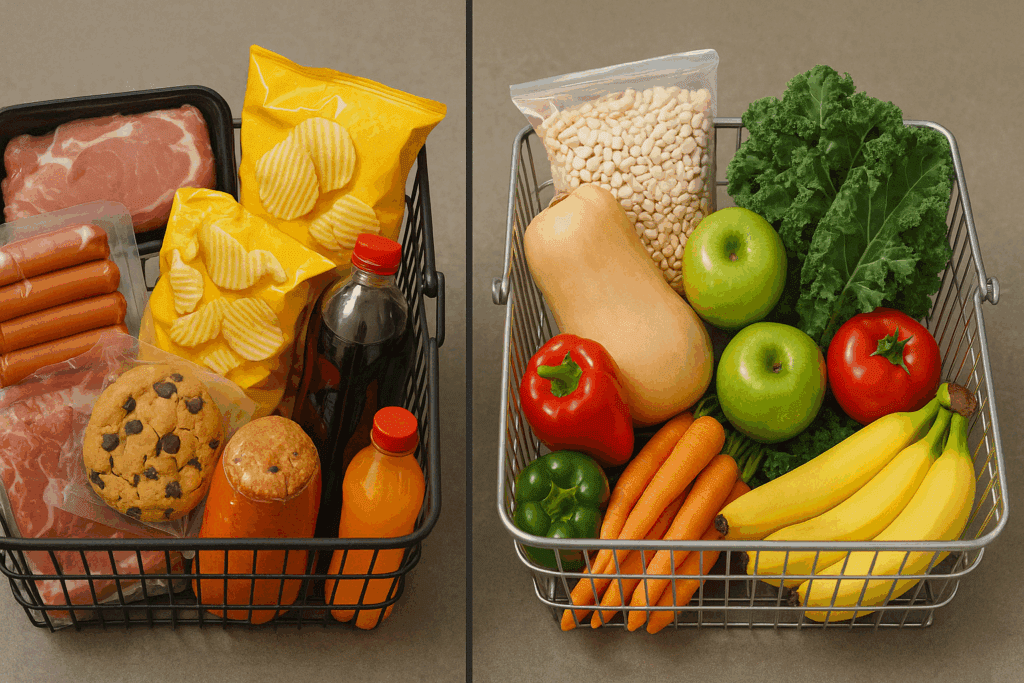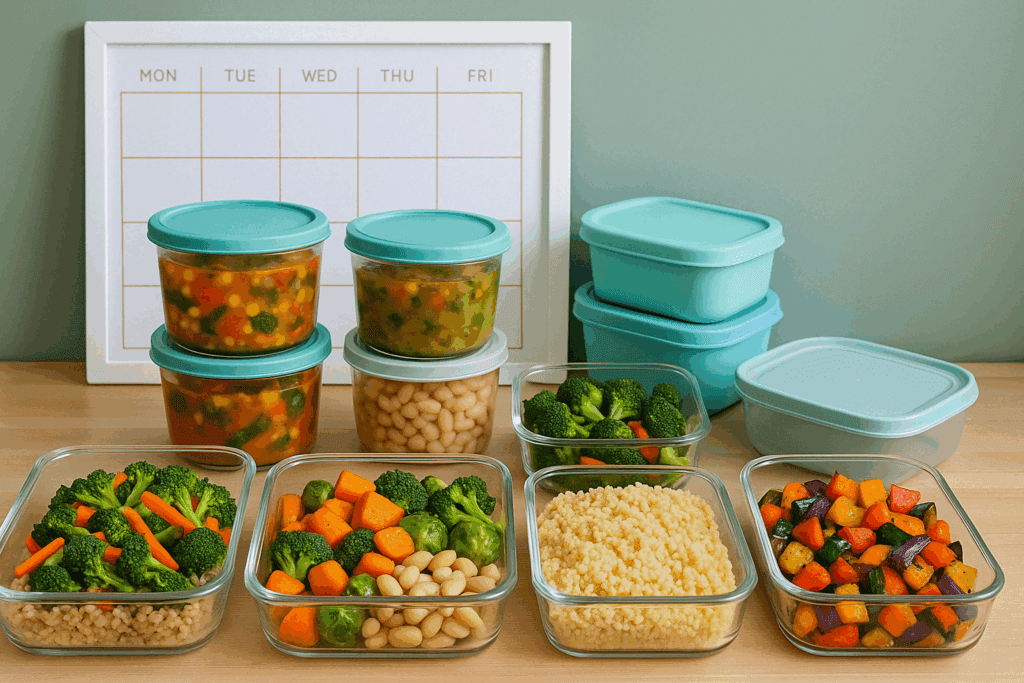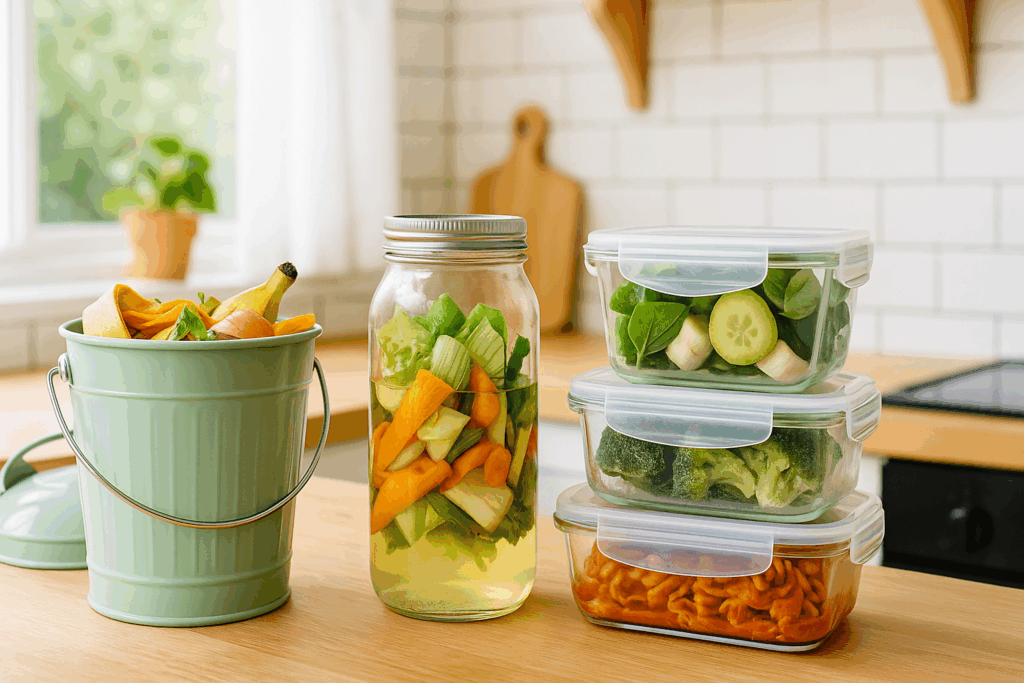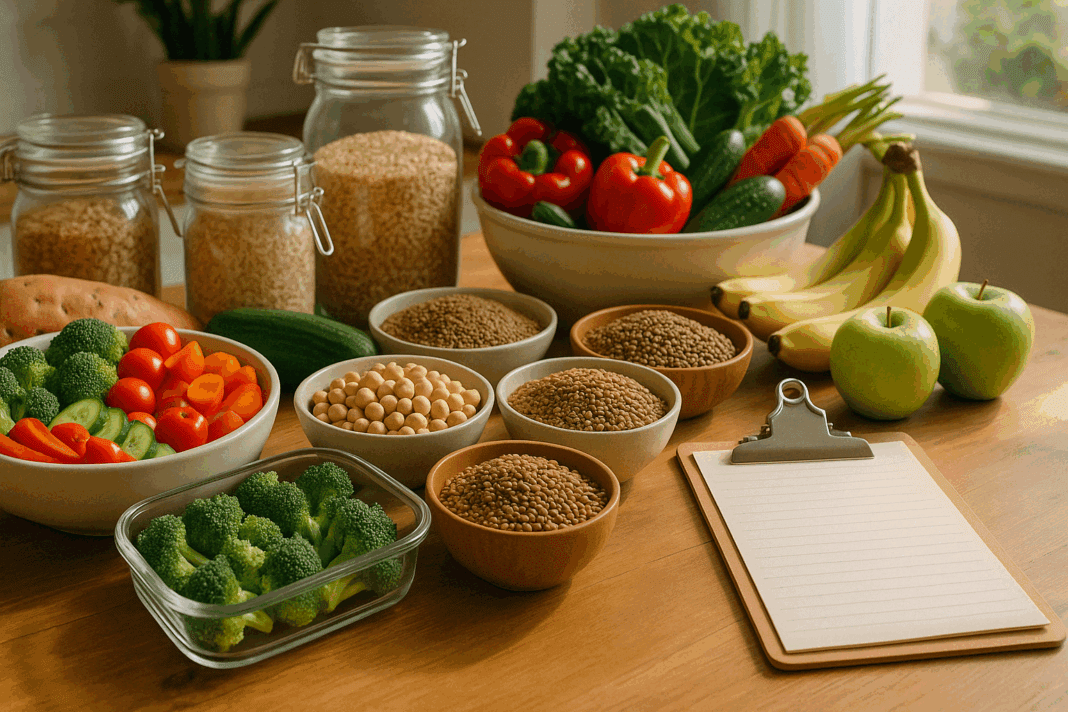Introduction: Reframing Affordability in a Plant-Based Lifestyle
As inflation and rising grocery prices continue to squeeze household budgets, many individuals seeking to prioritize their health through dietary choices find themselves caught in a familiar dilemma: how to eat well without overspending. For those exploring a plant-based lifestyle, the challenge is often compounded by misconceptions that such a diet requires specialty items, organic produce, or expensive substitutes. But what if we reframe the conversation? What if, rather than seeing whole-food plant-based nutrition as a luxury, we recognized it as one of the most effective and sustainable strategies for both health and financial well-being?
The truth is, a plant-based eating pattern built on nutrient-dense whole foods can be not only affordable but also remarkably accessible—when approached with strategy, intention, and a bit of culinary creativity. The key lies in shifting the focus from pre-packaged meat alternatives and superfood fads to the foundational elements of human nutrition: legumes, grains, vegetables, fruits, nuts, and seeds. These staples, when purchased and prepared with mindfulness, form the core of a budget plant based diet that offers powerful health benefits and long-term cost savings.
This article offers a deep dive into the practical, evidence-based strategies that support plant based eating on a budget, from smart grocery shopping techniques and meal planning methods to affordable substitutions and time-saving kitchen hacks. Whether you’re new to a plant-forward lifestyle or looking to refine your existing approach, you’ll discover that eating plant-based on a budget is not just possible—it’s empowering, satisfying, and sustainable.
You may also like: The Ultimate Vegetarian Grocery Shopping List for a Healthy, Plant-Based Lifestyle Backed by Nutrition Science

Understanding the True Cost of Food: Why Plant-Based Often Wins
To understand how a plant based on budget approach can work, it’s important to first take a closer look at the hidden costs of the Standard American Diet. Heavily reliant on processed meats, dairy, fast food, and packaged snacks, this pattern is not only linked to a range of chronic conditions—such as heart disease, type 2 diabetes, and certain cancers—but also tends to be financially draining over time. Medical bills, lost productivity, and the long-term cost of poor nutrition add up quickly.
In contrast, adopting a plant diet on a budget built on whole foods may initially appear to be more labor-intensive, but it pays dividends in the form of long-term health resilience. Consider the humble lentil: one cup of dried lentils yields multiple servings, packs a powerful punch of protein and fiber, and costs just a fraction of what a comparable meat-based meal might. When properly planned, plant-based meals are not only cheaper but often stretch further, creating leftovers that serve as lunches, side dishes, or the base for an entirely new meal.
Additionally, many plant-based staples have long shelf lives—think dry beans, brown rice, oats, canned tomatoes, and frozen vegetables—making them ideal for bulk purchasing and reducing food waste. These factors make a plant based grocery list on a budget not only practical but essential for those looking to reduce their overall spending without compromising nutrition.

Strategic Shopping: How to Build a Budget-Friendly Plant-Based Pantry
One of the most effective ways to begin plant based eating on a budget is to learn how to strategically stock your pantry and fridge. This doesn’t require an investment in boutique ingredients or specialty items. In fact, the most nutritious and versatile plant-based foods are often the most affordable.
Dried legumes such as black beans, chickpeas, and lentils are a cornerstone of budget-conscious eating. They provide essential amino acids, complex carbohydrates, and micronutrients such as iron and folate. When purchased in bulk, they can cost as little as a few cents per serving. Pair them with whole grains like brown rice, quinoa, barley, or oats, and you have a complete protein and a strong nutritional foundation for countless meals.
Frozen produce offers another excellent opportunity to save money without sacrificing quality. Vegetables like spinach, broccoli, and mixed stir-fry blends are often flash-frozen at peak ripeness, preserving nutrients and flavor. They are typically cheaper than fresh alternatives and come with the added benefit of a longer shelf life. Canned items—especially low-sodium beans and tomatoes—can be used to build quick meals on busy nights without relying on takeout or convenience foods.
When crafting a plant based diet on a budget shopping list, prioritize affordability, nutritional density, and versatility. This might include items like rolled oats for breakfasts, peanut butter for snacks and sauces, bananas and apples for fresh fruit options, and spices such as cumin, garlic powder, and smoked paprika to add depth and flavor to meals without extra cost.

Meal Planning with Purpose: Maximize Nutrition, Minimize Waste
Perhaps the single most powerful tool for maintaining a budget plant based diet is intentional, thoughtful meal planning. Rather than wandering the grocery store aisles in search of inspiration, successful plant-based eaters approach shopping with a clear plan: knowing exactly what meals they’ll prepare, how ingredients will be reused, and which items can be batch-cooked or frozen for later.
Begin by selecting three to five simple core recipes for the week, ideally ones that share common ingredients. For instance, a large pot of black beans can be used for tacos, added to a grain bowl, or turned into a hearty soup. Roasted vegetables can be repurposed into wraps, salads, or stir-fries. Planning in this way not only reduces the amount of food you buy but also ensures everything you purchase gets used before it spoils.
Batch cooking is another essential strategy in the toolkit of those who follow a plant based on budget lifestyle. Dedicating a few hours on the weekend to prepare grains, chop vegetables, and cook beans means you can assemble meals in minutes during the week. This minimizes reliance on costly takeout and drastically reduces food waste—two major sources of unnecessary spending.
Beyond the financial benefits, this approach also simplifies your mental load. By creating a consistent rhythm to your week—such as Meatless Monday, Taco Tuesday, or Stir-Fry Friday—you eliminate decision fatigue while making healthy eating a natural, effortless part of your routine.

Affordability Without Sacrifice: Swapping High-Cost Ingredients
One of the great strengths of a plant based diet on a budget is its flexibility. While trendy ingredients like jackfruit, nutritional yeast, or almond flour can add variety, they are by no means essential. In fact, some of the most expensive plant-based items are easily replaced with affordable alternatives that are equally delicious and nutritious.
For example, instead of expensive cashew-based cheese or nut milks, consider using blended tofu or oats as the base for creamy sauces and plant milks. Sunflower seeds and pumpkin seeds offer many of the same nutritional benefits as pricier nuts, often at half the cost. When baking, bananas or unsweetened applesauce can replace eggs or oil, providing moisture and natural sweetness while keeping expenses low.
Mushrooms, eggplant, and lentils can stand in for meat in a variety of recipes—from bolognese to burgers—without the need for expensive store-bought meat alternatives. Not only are these options more affordable, but they also tend to be lower in sodium and additives, making them a smarter health choice.
The goal is not to mimic an omnivorous diet but to embrace the abundance of textures, flavors, and nutrients available through plants. With a little creativity and a willingness to experiment, it’s possible to enjoy deeply satisfying meals that align with both your values and your budget.
Unlocking the Power of Local and Seasonal Foods for Budget Efficiency
One often-overlooked strategy in maintaining a plant diet on a budget is the conscious integration of local and seasonal produce. While it may be tempting to buy familiar items year-round, purchasing fruits and vegetables out of season can dramatically increase grocery costs. Strawberries in winter or tomatoes in the dead of February are often shipped from long distances, resulting in higher prices and diminished flavor. By contrast, buying what’s currently in season—especially from local growers—typically means better taste, higher nutritional value, and a lower price point.
Shopping at farmers’ markets or participating in a community-supported agriculture (CSA) program can lead to substantial savings, especially if you’re open to improvisation. A CSA box, for instance, might introduce you to hearty root vegetables in the winter or leafy greens in spring, encouraging culinary exploration while lowering the average cost per meal. In many cases, growers offer “seconds” at a discount—produce that may not look picture-perfect but is just as fresh and delicious.
Even mainstream supermarkets tend to offer significant markdowns on in-season produce because of increased supply and faster turnover. Planning your weekly meals around what’s currently at peak harvest enables you to make the most of these deals while ensuring variety and nutritional diversity in your diet. This approach can transform your plant based grocery list on a budget into a dynamic, ever-evolving selection of nutrient-rich ingredients that keep your meals interesting and cost-effective.

Reducing Food Waste as a Path to Budget Success
Reducing food waste is one of the most underestimated yet profoundly impactful ways to support plant based eating on a budget. According to the USDA, the average American household wastes approximately 30% of the food it purchases. That’s the equivalent of throwing hundreds, if not thousands, of dollars directly into the trash every year. For those committed to both budget consciousness and sustainable living, addressing this waste is non-negotiable.
Start by assessing your current habits. Are there particular foods that tend to go bad before you use them? Do you overbuy perishables out of ambition or habit? Creating a system for tracking and using leftovers is a simple yet effective way to stretch your grocery dollars. This might involve freezing portions of cooked grains, soups, or legumes, labeling items with dates, or building meals around ingredients you already have rather than defaulting to new purchases.
Composting is often framed as the ethical endpoint of food scraps, but the real goal should be upstream: reducing the scraps that need to be composted in the first place. Vegetable stems, peels, and scraps can be used to make homemade broth. Wilted greens can be sautéed or added to smoothies. Slightly overripe fruits can be baked, blended, or frozen for future use. In this way, a smart plant based diet on a budget shopping list becomes more than a checklist—it evolves into a cycle of intentional use, minimizing waste while maximizing nutrition and value.
Creative Cooking Techniques That Save Money
When following a budget plant based diet, how you prepare your food can be just as important as what you buy. Creative cooking techniques not only make simple ingredients taste exceptional but also stretch your ingredients further, allowing you to eat well with less. This begins with an understanding of foundational cooking methods—roasting, sautéing, simmering, and baking—and how these techniques enhance flavor without the need for expensive ingredients.
Roasting vegetables, for instance, caramelizes their natural sugars, bringing out deep, rich flavors. A tray of roasted sweet potatoes, carrots, and onions tossed with basic spices can serve as the centerpiece for several meals throughout the week. Sautéing aromatics like garlic, onion, and ginger at the start of a dish builds a flavorful base for soups, stews, and grain bowls without relying on processed sauces or additives. Meanwhile, slow-cooking beans or whole grains not only saves money but results in more texture and taste compared to their canned or instant counterparts.
Fermentation is another cost-effective cooking technique that adds both flavor and health benefits to your meals. Homemade kimchi, sauerkraut, or pickled vegetables can be made from inexpensive produce and help diversify your diet with probiotics that support digestive health. Similarly, learning to make your own plant-based condiments—like hummus, tahini dressing, or even homemade salsa—can elevate simple meals and replace store-bought versions at a fraction of the cost.
All of these approaches help you stretch the value of your plant based on budget staples while making mealtime something to look forward to, rather than a source of stress or monotony.
Plant-Based Protein on a Budget: Meeting Nutritional Needs Affordably
One of the most common concerns about eating plant-based—especially for those new to the lifestyle—is whether it’s possible to get enough protein without breaking the bank. The good news is that plant-based protein sources are some of the most affordable and nutrient-dense foods available. In fact, many staples that form the foundation of a plant based diet on a budget shopping list are naturally rich in protein, fiber, and essential micronutrients.
Beans and lentils are at the top of this list, offering roughly 15–18 grams of protein per cooked cup, along with significant amounts of iron, magnesium, and potassium. When purchased dry, they cost mere cents per serving and can be used in a wide variety of dishes. Tofu and tempeh—both made from soybeans—are versatile, high-protein ingredients that can be baked, grilled, or stir-fried with ease. While slightly more expensive than dried legumes, they’re still cost-effective compared to animal protein and often last several meals when properly portioned.
Whole grains like quinoa, bulgur, and farro also provide a protein boost, especially when combined with beans or legumes to form complete protein profiles. Even vegetables such as spinach, peas, and broccoli contribute meaningful amounts of protein when consumed in sufficient volume. And for snacks or supplemental energy, peanut butter, sunflower seed butter, and roasted chickpeas deliver protein, healthy fats, and satisfaction without exceeding your grocery budget.
By focusing on these whole-food protein sources and combining them intelligently, it’s entirely possible to meet your nutritional needs within a plant diet on a budget, without relying on expensive powders or supplements. The added benefit is that these foods also deliver fiber, antioxidants, and phytochemicals that promote overall health—a win-win scenario for body and wallet alike.
Making the Most of Leftovers: Reinventing Meals with Zero Waste
For anyone committed to plant based eating on a budget, leftovers are not a burden—they’re a blessing. Rather than viewing yesterday’s meal as repetitive, consider it the base for something new and exciting. Reinventing meals from existing ingredients not only reduces waste but also keeps you engaged and satisfied without the need to constantly start from scratch.
For instance, leftover lentils from a stew can be mashed with breadcrumbs and spices to create lentil burgers or meatballs. A portion of roasted vegetables can be folded into a tofu scramble or used as filling for wraps and quesadillas. Even cooked grains can be transformed into grain salads with the addition of a simple dressing, some beans, and fresh herbs or greens.
This approach encourages improvisation and creativity in the kitchen while aligning perfectly with the ethos of a budget plant based diet. It’s also a valuable skill for busy individuals and families who may not have time to cook fresh meals every day. By intentionally cooking larger batches and planning for reuse, you build flexibility and spontaneity into your meal routine.
It’s also helpful to keep basic condiments and spice blends on hand to give new life to leftovers. A drizzle of tahini dressing, a splash of hot sauce, or a sprinkle of dukkah can instantly transform a bowl of reheated rice and beans into something flavorful and satisfying. When you look at your fridge not as a graveyard of forgotten ingredients but as a toolkit for quick culinary innovation, the possibilities for plant based on budget dining expand exponentially.

Community Resources and Assistance for Plant-Based Eating on a Tight Budget
For those navigating a limited grocery budget, especially college students, single parents, or low-income households, accessing affordable plant-based foods can sometimes feel overwhelming. However, a wide range of community resources can make a plant based diet on a budget far more achievable than many realize. Government assistance programs such as SNAP (Supplemental Nutrition Assistance Program) and WIC (Women, Infants, and Children) often cover basic staples like whole grains, beans, frozen vegetables, and plant-based milks. These items form the backbone of a nutrient-rich plant-based diet, and learning how to shop wisely within these frameworks can greatly expand your options.
In many urban and rural areas, food banks and pantries are increasingly offering healthier food options, including fresh produce, shelf-stable legumes, and whole grains. Some even host plant-based recipe demonstrations or offer seasonal produce boxes. Additionally, nonprofit organizations and food justice initiatives are working to make plant based grocery lists on a budget accessible to all, regardless of income. Community fridges, mutual aid groups, and meal-sharing cooperatives offer creative and compassionate ways to source fresh, affordable food locally.
Utilizing these resources not only helps meet immediate food needs but also fosters a deeper sense of connection and empowerment. There is strength in community, and when individuals come together to support each other in their health and nutrition goals, the barriers to plant based eating on a budget become much easier to overcome. Even small steps—like attending a local cooking class or joining a Facebook group for plant-based meal prep—can make a big difference in both confidence and capability.
Budgeting Beyond the Grocery Store: Time, Energy, and Sustainability
It’s easy to focus solely on the cost of ingredients when evaluating a budget plant based diet, but financial affordability also intersects with time and energy. For many people, especially those juggling multiple jobs or caregiving responsibilities, the real challenge isn’t the cost of food—it’s the cost of time. Cooking from scratch takes planning, preparation, and often a steep learning curve for beginners. But with a few practical adjustments, plant-based eating can become not only economical but also time-efficient.
Start by recognizing the value of kitchen efficiency. Investing in a slow cooker, pressure cooker, or rice cooker—many of which can be found secondhand—can drastically cut down prep and cooking time. Freezing individual portions of soup, beans, or grain dishes creates quick, healthy meals for future days when time is short. Prepping ingredients once a week—chopping vegetables, cooking grains, soaking legumes—also reduces midweek chaos and helps avoid costly last-minute takeout.
In the long term, this approach offers far more than savings at the register. It supports sustainability—both environmental and personal. A plant based on budget lifestyle aligns with lower greenhouse gas emissions, reduced food waste, and a lighter ecological footprint. When individuals shift their eating habits in ways that also support planetary health, the ripple effects are profound.
Frequently Asked Questions: Smart Plant-Based Eating on a Budget
1. What’s the biggest psychological hurdle people face when switching to a budget plant based diet, and how can it be overcome?
Many people associate plant-based eating with restriction or sacrifice, especially when money is tight. The idea that you must give up satisfying, flavorful meals can lead to resistance, even before trying it. To overcome this mental block, it’s essential to reframe the narrative around abundance. A budget plant based diet isn’t about what you remove—it’s about discovering new, vibrant ways to nourish yourself with fewer resources. Exploring global cuisines, such as Indian dals or Mexican bean dishes, reveals how diverse and delicious a plant based on budget lifestyle can be, even with minimal ingredients.
2. How can someone on a plant diet on a budget still enjoy variety without constantly buying new ingredients?
Variety doesn’t require an ever-expanding shopping list. Instead, it comes from mastering flavor layering and cooking techniques. For example, one pot of lentils can become a soup, a curry, or a taco filling just by changing spices and aromatics. Learning to use a spice rack creatively allows you to transform the same core ingredients into entirely different meals. The key is building a modular plant based diet on a budget shopping list filled with flexible items like canned tomatoes, garlic, onions, and versatile grains. These staples unlock culinary diversity without overspending.
3. What are some lesser-known, high-impact items to include on a plant based grocery list on a budget?
While beans and rice are familiar staples, there are other overlooked powerhouses worth adding. For example, millet and amaranth are ancient grains that cook quickly and are rich in micronutrients. Cabbage, often underappreciated, is inexpensive, nutrient-dense, and lasts for weeks in the fridge. Frozen edamame is a cost-effective, high-protein snack or salad topper. And miso paste, though a bit pricey upfront, lasts months and enhances soups, sauces, and marinades. These items elevate a plant based grocery list on a budget with minimal financial strain and maximum nutritional return.
4. Can a plant based on budget diet support muscle growth or athletic performance?
Absolutely—athletes and fitness enthusiasts can thrive on a plant diet on a budget with proper planning. Lentils, tofu, tempeh, and even whole grains like quinoa provide essential amino acids. Pairing complementary proteins—such as beans and rice—helps build muscle effectively. Recovery is also supported by antioxidant-rich foods like berries, greens, and turmeric. You don’t need expensive protein powders; a well-structured budget plant based diet can be performance-optimized with whole foods. Some Olympic athletes even follow a plant based on budget lifestyle, proving its efficacy at the highest levels.
5. How can parents help kids transition to a plant-based eating pattern affordably?
Introducing kids to plant based eating on a budget can be fun and educational. Start by involving them in meal prep—let them wash vegetables, stir a pot, or choose from a “rainbow plate” of colorful produce. Focus on kid-friendly recipes like lentil sloppy joes, chickpea nuggets, or build-your-own burrito bowls. Reinforcing positive language around food (“power greens” instead of “vegetables”) helps build enthusiasm. Making affordable, nutrient-packed meals part of a family routine ensures children benefit from a budget plant based diet without feeling deprived.
6. Are there effective ways to meal prep when space and equipment are limited?
Yes, and this is especially relevant for students, small households, or those in shared living situations. Focus on one-pot meals and no-cook options like overnight oats, salads, and wraps. Batch-cook items like rice or lentils using a rice cooker or stovetop, and refrigerate them in stackable containers. Consider portable tools like a mini blender or electric skillet that don’t take up much space. Even with limited tools, a minimalist approach to plant based diet on a budget shopping list can yield efficient, satisfying results if planned strategically.
7. What are some cultural or regional cuisines that naturally support a plant based on budget lifestyle?
Many global cuisines are inherently plant-forward and affordable. Indian cuisine offers dal, aloo gobi, and chana masala—protein-rich dishes made from lentils and vegetables. Ethiopian dishes like misir wot (spiced lentils) served with injera are both economical and nourishing. Latin American staples include rice, black beans, and plantains. These culinary traditions emphasize whole foods, spices, and local produce, providing inspiration for your plant based grocery list on a budget while expanding your palate. Exploring these cuisines adds both affordability and excitement to your meals.
8. How can someone deal with social pressure or stigma when eating a plant diet on a budget?
Social dynamics can pose real challenges, especially when peers equate budget-conscious eating with deprivation or assume a plant based on budget lifestyle is somehow “less than.” One way to counter this is by inviting friends or family to share a homemade, budget-friendly plant-based meal. A hearty lentil shepherd’s pie or black bean chili can win over skeptics and open conversations. Sharing knowledge about the economic and health benefits of your choices helps shift the narrative. Empowerment grows when others see the richness and flavor that a budget plant based diet can offer.
9. What future trends might make plant based eating on a budget even easier?
Several emerging trends promise to support the accessibility of plant based eating on a budget. Urban vertical farming and hydroponic systems are making fresh greens more affordable and local. Food co-ops and zero-waste stores are expanding bulk-buy options. New digital tools like AI-driven meal planners and dynamic grocery apps are helping users optimize their plant based diet on a budget shopping list. Community fridges and decentralized food-sharing platforms are also democratizing access to surplus produce. These innovations suggest a promising future for equitable, plant-based living.
10. How does following a plant based grocery list on a budget impact long-term financial and medical costs?
Following a consistent plant based grocery list on a budget often leads to long-term savings far beyond the checkout line. Preventative nutrition—rich in fiber, phytonutrients, and antioxidants—can reduce the risk of chronic conditions like hypertension, heart disease, and diabetes. Lower incidence of illness translates into fewer medical bills, prescription medications, and insurance costs. Additionally, healthier eating often improves productivity, focus, and energy levels, creating economic benefits through enhanced well-being. In the long run, investing in a plant diet on a budget is a strategic move for both health and financial stability.
Conclusion: Nourishing Health and Humanity Through Affordable Plant-Based Living
At its heart, the journey toward plant based eating on a budget is not about restriction—it’s about liberation. It frees us from the myth that good nutrition must come at a high price. It breaks the cycle of relying on expensive, processed foods and empowers us to reclaim our health, our kitchens, and our relationship with food. A budget plant based diet is not simply a compromise for those with limited means—it is a practical, health-forward approach that supports longevity, vitality, and community resilience.
Through strategic planning, intelligent shopping, and creative cooking, individuals can build a lifestyle that reflects both their values and their financial reality. Whether you’re compiling a plant based diet on a budget shopping list for a family of five or navigating weekly meals as a student with minimal resources, the principles remain the same: prioritize whole foods, reduce waste, plan ahead, and stay flexible. With time, these practices become habits—ones that nourish both the body and the budget.
Moreover, the power of a plant based grocery list on a budget extends beyond personal health. It is an act of environmental stewardship and food justice. It allows individuals to opt out of systems that exploit labor and the planet, and instead, support more equitable, ethical food production. And in doing so, it also opens the door to better health outcomes—lower cholesterol, improved gut health, stable energy levels, and reduced risk for many chronic diseases, as supported by a growing body of scientific research.
Ultimately, plant-based living on a budget is not just a possibility—it’s a powerful form of self-care and social change. By choosing foods that are nutrient-dense, cost-effective, and environmentally conscious, we take meaningful steps toward a healthier, more sustainable future. And in that future, everyone—regardless of income—deserves access to good food, vibrant health, and the dignity of choice.
Further Reading:
6 Best Tips for Eating Plant-Based on a Budget
Healthy and Affordable: Tips for Eating Plant-Based on a Budget
Vegan on a Budget: How to Eat Plant-Based Without Breaking the Bank

